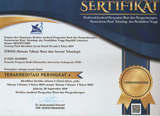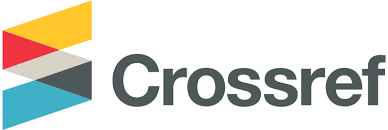Data Mining Menggunakan Association Rules-Market Basket Analysis untuk Peningkatan Kinerja Ritel Tradisional
(1) Universitas Islam Indonesia
(*) Corresponding Author
Abstract
Traditional retail, as well as micro, small, and medium-sized firms, play an important part in the Indonesian economy. However, with the rise of progressive business competition, such as competition from modern retail, traditional retail requires a strategy to better its business and performance. The purpose of this study is to identify consumer behavior in traditional retail based on data mining using Association rules-market basket analysis (AR-MBA). Data were gathered by collecting 150 shopping transactions. Furthermore, the pre-processing stage involved data cleansing, transformation, and reduction. The study's findings revealed that several association rules were established and validated. Based on these findings, various insights were obtained, including the fact that department 3 (snacks) is the most purchased item and is associated with items in other departments; there are association rules between powdered drinks and snacks, candy and snacks, toiletries, snacks, instant noodles and snacks, cigarettes and flavored drinks, and mineral water and flavored drinks. The findings are used to improve the performance and to expand the retail industry. This study recommends product stock management by increasing the number of products that consumers frequently purchase, product marketing strategies such as discounts, product bundling, and other promotions, and layout proposals based on association rules.
Keywords
Full Text:
PDFReferences
A. Mardhiyah and F. Safrin, “Persaingan Usaha Warung Tradisional dengan Toko Modern,” J. Bisnis Dan Manaj., vol. 8, May 2021, doi: 10.26905/jbm.v8i1.5454.
Y. M. Putri, R. Agatha, and R. N. Amelia, “Strategi Bertahannya Warung Kelontong Dalam Gempuran Market Modern,” J. Sos. Hum. Dan Pendidik., vol. 2, no. 2, pp. 164–170, 2023.
I. K. Wati and H. Ispriyahadi, “Analisis Swot Serta Pemanfaatan Digital Marketing dalam Upaya Pengembangan Pemasaran Warung Ridho di Lampung Selatan Pada Masa Covid-19,” Musytari Neraca Manaj. Akunt. Dan Ekon., vol. 1, no. 12, pp. 121–130, 2023.
I. Costa Melo, P. N. Alves Junior, J. S. Callefi, T. K. Kodama, M. S. Nagano, and D. A. N. Rebelatto, “A Performance Index For Traditional Retailers Incorporating Digital Marketplace: Benchmarking Through Data Envelopment Analysis (DEA),” J. Organ. Comput. Electron. Commer., vol. 32, no. 3–4, pp. 196–216, Oct. 2022, doi: 10.1080/10919392.2023.2177070.
M. E. Isharyani, B. M. Sopha, M. A. Wibisono, and B. Tjahjono, “Retail technology adaptation in traditional retailers: A technology-to-performance chain perspective,” J. Open Innov. Technol. Mark. Complex., vol. 10, no. 1, p. 100204, 2024.
R. Yan and S. Ghose, “Forecast information and traditional retailer performance in a dual-channel competitive market,” J. Bus. Res., vol. 63, no. 1, pp. 77–83, 2010.
A. Dogan and D. Birant, “Machine learning and data mining in manufacturing,” Expert Syst. Appl., vol. 166, p. 114060, 2021.
J. Han, J. Pei, and H. Tong, Data mining: concepts and techniques. Morgan kaufmann, 2022. Accessed: Dec. 15, 2024. [Online]. Available: https://books.google.com/books?hl=id&lr=&id=NR1oEAAAQBAJ&oi=fnd&pg=PP1&dq=data+mining+&ots=_N4GOKwllY&sig=axKfEfo-UGC82B46p8t7EF16FD4
M. Fathurrahman, A. R. Pratama, and T. Al-Mudzakir, “Perbandingan Algoritma Apriori Dan Fp Growth Terhadap Market Basket Analysis Pada Data Penjualan Bakery,” Kesatria J. Penerapan Sist. Inf. Komput. Dan Manaj., vol. 4, no. 2, pp. 266–274, 2023.
Y. S. Putra, R. Kurniawan, and Y. A. Wijaya, “Penerapan Data Mining Menggunakan Algoritma Fp-Growth Pada Data Penjualan Sembako,” JATI J. Mhs. Tek. Inform., vol. 8, no. 1, pp. 561–567, 2024.
R. Takdirillah, “Penerapan Data Mining Menggunakan Algoritma Apriori Terhadap Data Transaksi Penjualan Bisnis Ritel,” Edumatic J. Pendidik. Inform., vol. 4, no. 1, pp. 37–46, 2020.
M. Al-Mashraie, S. H. Chung, and H. W. Jeon, “Customer switching behavior analysis in the telecommunication industry via push-pull-mooring framework: A machine learning approach,” Comput. Ind. Eng., vol. 144, p. 106476, 2020.
T. Petcharat and A. Leelasantitham, “A retentive consumer behavior assessment model of the online purchase decision-making process,” Heliyon, vol. 7, no. 10, 2021, Accessed: Dec. 16, 2024. [Online]. Available: https://www.cell.com/heliyon/fulltext/S2405-8440(21)02272-6
D. A. Purnama, Subagyo, and N. A. Masruroh, “Online data-driven concurrent product-process-supply chain design in the early stage of new product development,” J. Open Innov. Technol. Mark. Complex., vol. 9, no. 3, p. 100093, Sep. 2023, doi: 10.1016/j.joitmc.2023.100093.
Subagyo, D. A. Purnama, N. A. Masruroh, and R. R. Pratama, “Modeling Dynamic Consumer Preferences in Product Attributes for Social Media-Based Product Improvement Planning,” Malays. J. Consum. Fam. Econ., vol. 32, no. 1, pp. 104–140, Jun. 2024, doi: 10.60016/majcafe.v32.05.
J. Wang, J.-Y. Lai, and Y.-H. Lin, “Social media analytics for mining customer complaints to explore product opportunities,” Comput. Ind. Eng., vol. 178, p. 109104, Apr. 2023, doi: 10.1016/j.cie.2023.109104.
DOI: http://dx.doi.org/10.30998/string.v9i3.28707
Refbacks
- There are currently no refbacks.
Copyright (c) 2025 Dwi Adi Purnama

This work is licensed under a Creative Commons Attribution 4.0 International License.
STRING (Satuan Tulisan Riset dan Inovasi Teknologi) indexed by:

Ciptaan disebarluaskan di bawah Lisensi Creative Commons Atribusi 4.0 Internasional.
View My Stats


 Sertifikat Akreditasi
Sertifikat Akreditasi
















